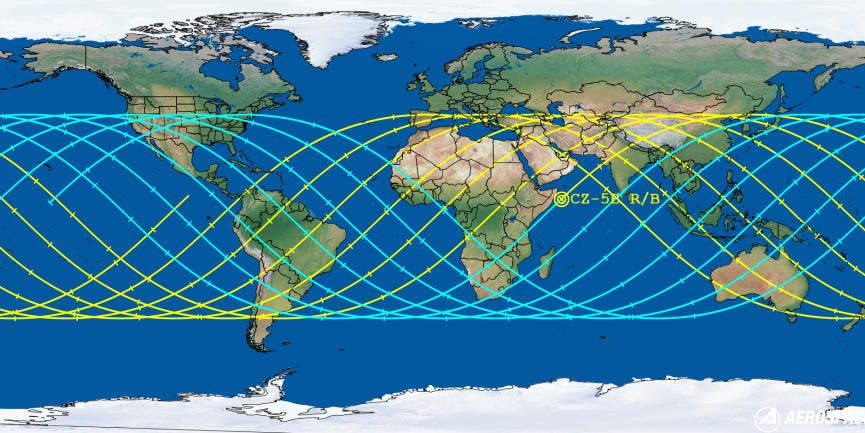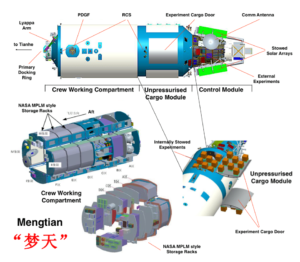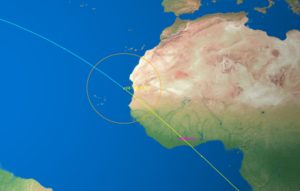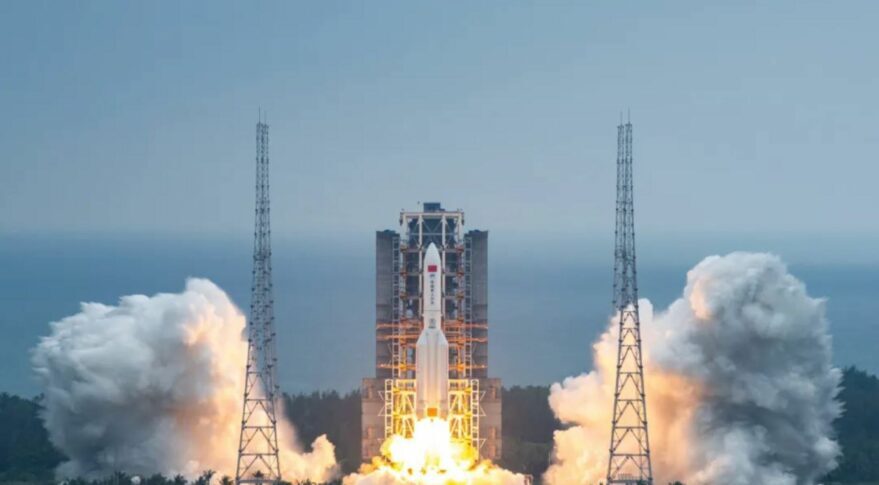3.11.2022

Each line shows where the out-of-control rocket may tumble back to Earth on its final orbits around the globe in the coming days. The blue line shows ground track uncertainty prior to the middle of the re-entry window while the yellow line shows the ground track uncertainty after the middle of the reentry window. Each tick shows the distance covered in a 5 minute period, reinforcing just how fast this object is racing back to Earth. Image: Aerospace Corporation
Yet again, an out-of-control spent rocket launched by China in recent days is racing back towards Earth and what’s left of it is now forecast by Aerospace Corporation to strike the planet somewhere in about 48 hours. Traveling at speeds of around 15,000 mph, the massive rocket body could strike somewhere in the southern two thirds of the United States from the California/Oregon border to the New York / Pennsylvania border and points south, including the island of Hawaii. It’s also possible the out-of-control rocket or its debris will strike a commercial aircraft flying above or around the U.S., a threat that became realized when planes were threatened by China’s last out-of-control rocket.
Aerospace Corporation is one of a few entities located around the world tracking this huge rocket as it tumbles back to Earth. The Long March 5b is huge: it weighs about 20 tons and has the height of a ten story building. Fortunately, according to Aerospace Corporation, not all of it will survive the re-entry to earth.
“The general rule of thumb is that 20–40% of the mass of a large object will reach the ground, but the exact number depends on the design of the object,” wrote Marlon Sorgem a technical fellow for the Space Innovation Directorate of the Aerospace Corporation in an online question and answer session specific to an out-of-control Chinese rocket. “In this case, we would expect about five to nine metric tons. Generally, for an upper stage, we see small and medium tanks survive more or less intact, and large engine components. The large tanks and the skin of this core stage are likely to come apart. We will also see lightweight items such as insulation fall out. The melting point of the materials used will make a difference in what remains.”
This is the fourth time in as many years China has launched a massive rocket into space with no plans to safely return it to Earth. Despite international condemnation of China’s last out-of-control rocket which struck Earth in May of last year, which followed another similar impact in May of 2020, China has not employed any new technology or safety mechanisms to steer the rocket back to Earth safely, as SpaceX rockets do, or deposit rockets in the South Pacific ocean far from any land mass or ocean shipping routes, as what most rocket launchers around the world do when sending satellites into space.

While the end of this week will be the fourth time for an out-of-control rocket from China to crash into the Earth in as many years, other countries have had mishaps too. In January of this year, a rocket from Russia crashed after an uncontrolled re-entry into the Earth’s atmosphere. Even the U.S. and NASA has problems every now and then too; according to the Center for Orbital and Reentry Debris Studies, a woman walking through a park in Tulsa, Oklahoma was apparently hit by debris from a NASA rocket. While she was walking outside through a park, she saw a fireball in the sky above and felt something strike her shoulder. Fortunately, the palm-sized chunk of metal didn’t injure her, but analysis showed the debris was a part of a fuel tank from a Delta II rocket that NASA had used to launch a satellite into space.
In May 2021, NASA Administrator Senator Bill Nelson released a statement about the then-out-of-control Chinese rocket: “Spacefaring nations must minimize the risks to people and property on Earth of re-entries of space objects and maximize transparency regarding those operations. It is clear that China is failing to meet responsible standards regarding their space debris. It is critical that China and all spacefaring nations and commercial entities act responsibly and transparently in space to ensure the safety, stability, security, and long-term sustainability of outer space activities.”
On Halloween, October 31, China launched their massive Long March 5B rocket to deliver the third and final experiment module to China’s Tiangong Space Station. Known as the Mengtian module, it was lifted into space successfully by an estimated 22.5 metric ton core booster. Unable to participate in the International Space Station (ISS) due to restrictions imposed by the United States, China has embarked on building their own called “Tiangong.” With the ISS due to be retired in the coming years, Tiangong may remain as the only working space station in Earth’s orbit.
The Long March 5, developed by the China Academy of Launch Vehicle Technology, roughly matches the capabilities of American rockets like the ULA Delta IV Heavy and the SpaceX Falcon Heavy. The massive rocket that was used to bring the GOES-R and GOES-S weather satellites to orbit was a ULA Atlas V; despite its size, it’s considerably smaller and less powerful than the Long March 5. The Long March 5 core stage has roughly 7x the mass of the Space X Falcon 9 second stage. The Long March 5b launches from a spaceport on Hainan Island in southeastern China.
The Wenchang facility on Hainan Island allows launch vehicles to soar over the South China Sea; previous launches lifted-off from inland launch facilities, forcing used rocket stages to fall onto land. Previous rocket stages have crashed into people’s homes in China. In the United States, such launches lift-off from launchpads near water, allowing spent rocket stages to tumble back to the ocean. Prior to such an event, NASA in partnership with local government agencies, put the projected splash-down area as a “no-fly” / “no-boat” area until the debris is safely down.
However, as was the case when China launched space station components in 2020 and 2021, it appears the spent Long March 5 main stage will tumble back to Earth in an uncontrolled manner, potentially threatening some location on the planet with an impact. While experts believe much of the large spent rocket stage will burn-up upon re-entry, it is possible some parts of it, such as its massive motors, may survive re-entry and impact Earth. The spent rocket stage is roughly 100 feet long by 16 feet wide. This is approximately the same size as 4 school buses, parked 2 by 2.

In 2020, Aerospace Corporation tracked the falling space debris. In March of 2018, Aerospace also tracked a falling Chinese space station. It eventually crashing into the ocean. It is too soon to know with precision where and when this giant rocket or its remnants will crash. Aerospace Corporation operates the only federally funded research and development center (FFRDC) committed exclusively to the space enterprise.
Of the uncontrolled reentries of Long March rockets in 2020, 2021, and 2022, two resulted in large debris landing near populated areas. According to Aerospace Corporation, over 88% of the world’s population lives under the reentry’s potential debris footprint.
The U.S. Space Force is tracking the falling Chinese rocket. Created in December 2019, the U.S. Space Force has been busy. If an entity in space or tumbling from space were to threaten U.S. interests, they’d work in partnership with other military branches and government teams to respond to the threat.

In the meantime, Aerospace Corporation and others will continue to track and forecast where impact is likely to occur. “There are a variety of ways to predict the reentry, and models differ,” said Aerospace Corporation’s Marlon Sorge, who is a technical fellow for Space Innovation Directorate in an online question and answer session. “The predictions are highly sensitive to the modeling assumptions including how we think the sun will affect the earth’s atmosphere which affects how quickly an object falls out of orbit. We and the U.S. Space Force use slightly different models so we get different answers. These different answers tend to fall within each other’s uncertainties, so just because they are not identical does not mean they don’t agree. We are constantly refining our models and are satisfied with our approach in the face of the unknowns.”
Quelle: WEATHERBOY
+++
Not again! Another massive rocket body is about to crash back to Earth
Second Long March 5B core stage to arrive on the surface sometime this week.
Where will it land this time?
For the second time in 2022, and the fourth time in three years, a Chinese rocket core will blast through Earth’s atmosphere and crash somewhere on the planet’s surface.
The rocket was launched on Monday local time to deliver the Mengtian module that will finalise the construction of the Tiangong Space Station.
Meanwhile, the ejected core stage of the Long March 5B rocket that sent Mengtian to space will return to Earth in an uncontrolled reentry, most likely in the early hours (UTC) of November 5.
Observers will track the 22.5 tonne, 30-metre core stage in the days leading up to the impact.
The Aerospace Corporation tracks large space debris and says the risk to human lives is substantial, due to the uncontrolled re-entry.
Long March 5B core stages are among the largest objects to re-enter earth without guidance in decades. Most such objects ignite spare fuel to provide a precise ‘dump’ into uninhabited areas.
“Over 88 percent of the world’s population lives under the re-entry’s potential debris footprint,” the Aerospace Corporation said in a statement.
“Factors such as the rocket core’s uncontrolled manner of descent and its size, which is too large to entirely burn up in the Earth’s atmosphere, collectively present risks high enough that require additional precautionary preparation around the world.”
The last return of a Long March 5B core stage was in July. US Space Command confirmed the final splashdown was in the Sulu Sea off the Philippine coast. Fragments of the core were reportedly found in Malaysia.
Earlier this year, researchers from the University of British Columbia found there was a one-in-ten chance a person would be killed by returning space junk within the decade, and that regions in the global socioeconomic south disproportionally bore the risk of such events happening.
Quelle: COSMOS
----
Update: 7.11.2022
.
Long March 5B rocket reenters over Pacific Ocean after forcing airspace closures in Europe

HELSINKI — A large rocket stage used to launch the final module for China’s space station made an uncontrolled reentry into the atmosphere Friday after precautionary airspace closures took effect in southern Europe.
The roughly 21-metric-ton dry mass Long March 5B rocket stage reentered over the south-central Pacific Ocean at 6:01 a.m. Eastern (10:01 UTC) Nov. 4, according to the U.S. Space Command, just over four days after its launch.
The reentry event had been tracked by U.S. and European authorities which provided predictions for the reentry. China’s human spaceflight agency, CMSA, regularly released orbital data updates for the rocket stage but provided no predictions.
China launched the third and final module for its Tiangong space station with the fourth Long March 5B rocket Oct. 31. The Mengtian module successfully docked with the station 13 hours later.
As with China’s previous space station module launches, the Long March 5B first stage also acts as the upper stage for the mission and entered orbit, which is exceptional in international spaceflight.
The stage reentered over the Pacific Ocean but not before causing issues for air traffic in Europe, due in part to the uncertainty in predicting reentry events.
A section of airspace over northern Spain was closed early Friday based on a bulletin issued by the European Aviation Safety Agency (EASA) Nov. 3 based on predictions from the EU Space Surveillance and Tracking (EUSST). France also closed airspace south of Corsica from 9:30 to 10:30 a.m. local time.
The bulletin noted a number of cities potentially to be affected based on ground tracks including Lisbon in Portugal, Barcelona and Madrid in Spain, Marseille in France, and Rome in Italy.
The advisory recommended National Aviation Authorities regularly monitor and take into consideration predictions of the Long March 5B reentry and further recommended that, “the respective authorities of the affected Member States to consider implementing and notifying airspace restrictions on a path of minimum 70 km and up to 120 km on each side of the estimated re‐entry trajectory, a few minutes before and after the time window.”
The large prediction windows for the reentry are due to the challenges of modeling, including variables such as atmospheric fluctuations which affect how quickly the orbit of an object decays. Prediction windows are on the order of hours even within a day on the reentry.
Objects in low Earth orbit travel at nearly eight kilometers per second, meaning a deviation of even a few minutes means a reentry more than a thousand kilometers away.
The Long March 5B reentry is a large and prominent symptom of a wider problem. A recent Nature Astronomy paper published earlier assesses that current practices mean there is a 10 percent chance of uncontrolled reentries causing one or more casualties over a decade.
Around 50 objects with a mass of more than one ton reenter the atmosphere randomly each year, according to the Aerospace Corporation.
Long March 5B reentries account for four of the six largest objects making uncontrolled reentries. The reentries of the U.S.’s Skylab in 1979 and the Soviet Union’s Salyut 7 in 1991, at roughly 77 tons and 40 tons respectively, are the only higher mass events.
China’s next apparent scheduled use of the Long March 5B is to launch the Xuntian observatory around late 2023 or 2024. Xuntian is a Hubble-class space telescope which will co-orbit with the Tiangong space station.
Quelle: SN
